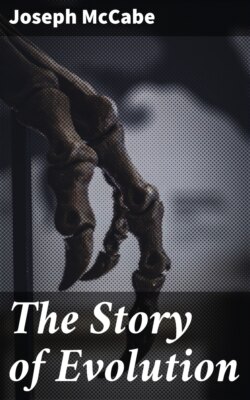The Story of Evolution

Реклама. ООО «ЛитРес», ИНН: 7719571260.
Оглавление
Joseph McCabe. The Story of Evolution
The Story of Evolution
Table of Contents
PREFACE
THE STORY OF EVOLUTION
CHAPTER I. THE DISCOVERY OF THE UNIVERSE
CHAPTER II. THE FOUNDATIONS OF THE UNIVERSE
CHAPTER III. THE BIRTH AND DEATH OF WORLDS
CHAPTER IV. THE PREPARATION OF THE EARTH
CHAPTER V. THE BEGINNING OF LIFE
CHAPTER VI. THE INFANCY OF THE EARTH
CHAPTER VII. THE PASSAGE TO THE LAND
CHAPTER VIII. THE COAL-FOREST
CHAPTER IX. THE ANIMALS OF THE COAL-FOREST
CHAPTER X. THE PERMIAN REVOLUTION
CHAPTER XI. THE MIDDLE AGES OF THE EARTH
CHAPTER XII. THE AGE OF REPTILES
CHAPTER XIII. THE BIRD AND THE MAMMAL
CHAPTER XIV. IN THE DAYS OF THE CHALK
CHAPTER XV. THE TERTIARY ERA
CHAPTER XVI. THE FLOWER AND THE INSECT
CHAPTER XVII. THE ORIGIN OF OUR MAMMALS
CHAPTER XVIII. THE EVOLUTION OF MAN
CHAPTER XIX. MAN AND THE GREAT ICE-AGE
CHAPTER XX. THE DAWN OF CIVILISATION
CHAPTER XXI. EVOLUTION IN HISTORY
Отрывок из книги
Joseph McCabe
Published by Good Press, 2019
.....
The next step was for students (notably Soddy and Rutherford) to find that radio-activity, or spontaneous discharge out of the atomic systems, was not confined to radium. Not only are other rare metals conspicuously active, but it is found that such familiar surfaces as damp cellars, rain, snow, etc., emit a lesser discharge. The value of the new material thus provided for the student of physics may be shown by one illustration. Sir J. J. Thomson observes that before these recent discoveries the investigator could not detect a gas unless about a billion molecules of it were present, and it must be remembered that the spectroscope had already gone far beyond ordinary chemical analysis in detecting the presence of substances in minute quantities. Since these discoveries we can recognise a single molecule, bearing an electric charge.
With these extraordinary powers the physicist is able to penetrate a world that lies immeasurably below the range of the most powerful microscope, and introduce us to systems more bewildering than those of the astronomer. We pass from a portentous Brobdingnagia to a still more portentous Lilliputia. It has been ascertained that the mass of the electron is the 1/1700th part of that of an atom of hydrogen, of which, as we saw, billions of molecules have ample space to execute their terrific movements within the limits of the letter "o." It has been further shown that these electrons are identical, from whatever source they are obtained. The physicist therefore concludes—warning us that on this further point he is drawing a theoretical conclusion—that the atoms of ordinary matter are made up of electrons. If that is the case, the hydrogen atom, the lightest of all, must be a complex system of some 1700 electrons, and as we ascend the scale of atomic weight the clusters grow larger and larger, until we come to the atoms of the heavier metals with more than 250,000 electrons in each atom.
.....